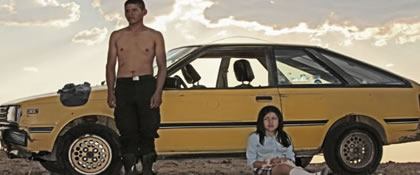We caught up with director Amat Escalante to find out about his new film
Screened at the Cannes Film Festival in 2013, HELI tells the story of a young man with a new family, who is forced into the Mexican underworld after his 12-year-old sister’s boyfriend gets on the wrong side of the police. The film went on to win Best Director at the festival, and is released in Irish cinemas this week. We caught up with the film’s director – Amat Escalante – at the Cannes press conference to find out more about the violence and horror shown in HELI…
When you were writing the screenplay, did you always want to have a strong and shocking image at the start?
AE: That first shot was one of the few images that came to me before I wrote the script. It was an anchor point, and it helped me to know where I wanted to go. I always knew I wanted to start the movie with that image, I tried to change it in the editing and it didn’t work, so I left it there.
Your film shows a world in fear and violence; do you think this has changed in recent years?
AE: I live there, but the movie is not completely inspired by what I have lived. It’s inspired by my love of cinema; Sergio Leone Western movies. I can choose from the many things that are happening in Mexico, put them together and make a movie that I like, and that I hope other people like. It’s not an anti-tourism movie for Mexico; it’s a drama, it’s quite extreme… I think the reality is even worse in Mexico, but not the every day reality. It’s a very beautiful country. It’s a fictional movie, it’s not a documentary, and we didn’t set out to make some analysis of the situation in the country at the moment. It’s a great country, a beautiful country, which has a virus that infects certain parts and many people are suffering from it. I felt we had to show it. It came very naturally. We had to have the mother of the baby on set, and she was 14 years old, this is in part because abortion is illegal in the state I live in. I saw that type of thing every day in my city.
Films like AMORES PERROS use violence to show contradictions in Latin America, do you see a connection between your movie and these movies that have gone before?
AE: I wanted to go beyond the page turning violence that one is confronted with when you read the news; you see it and you can turn the page, and that’s it. Here, I wanted to analyse or go deep into something else beyond the violence. I tried to show the violence that we show on the screen, but also the context; the people who are causing it and the people who are seeing it. That was important for me; otherwise I wouldn’t be interested in making the movie. If I wanted just to show violence for the sake of violence, I could make something and put it on YouTube. I have some kind of need to show the context and the way that violence is affecting the young people in the movie. These movies all come from countries where corruption and drug money are an important part of the economy; maybe that are what they have in common. They are filmed in countries like this, where corruption and drugs are more rampant than usual.
The violence was often graphic and filmed in an unblinking, detached way. Were you trying to show violence in a different way to Hollywood?
AE: Not consciously, so much. In cinematic terms, I am trying to find a way to film things in a way that I haven’t seen before. Every shot of the movie is that. With the violence, I tried to go in a way that I haven’t seen before, and get the attention of the audience. Also, if I am going to show violence in the way it should be shown. What’s the point of not showing the violence so the audience can go through the story and not suffer so much, when actually, that’s not the way violence is in real life? It’s very painful, depressing and sad, and if I am going to deal with violence… We didn’t write a comedy, so in a moral way, I think the responsibility is to show the violence how it should be; sad and unpleasant and dirty and a nightmare.
There are young children present in one of the most violent scenes in the film, can you talk about that?
AE: That was the whole point of that scene; I wouldn’t have included the scene if it was a bunch of men in the room, because we have seen that. The reality is that this is true. Children are being passed through the situation, and that’s what’s sad. I couldn’t show it half way, if I was going to show it all. Hitchcock said ‘If you don’t show it, it’s more powerful’, but I have tried to do the opposite.
There is a constant battle regarding sexuality in the film, how did that fit into your concept of the film?
AE: I think we are always trying to escape somewhere, I think, for the character of Heli, he is trying to find something in love and sex; something he can’t find, maybe. His wife just had a baby and she doesn’t feel like giving him sex. I am curious about sex and death and violence, and they are all in the film. For me, sex in the film is always the last hope that there is. That’s where everything can be saved or destroyed; by creating new life and having sex.
HELI is released in Irish cinemas from May 23rd
Words: Brogen Hayes


